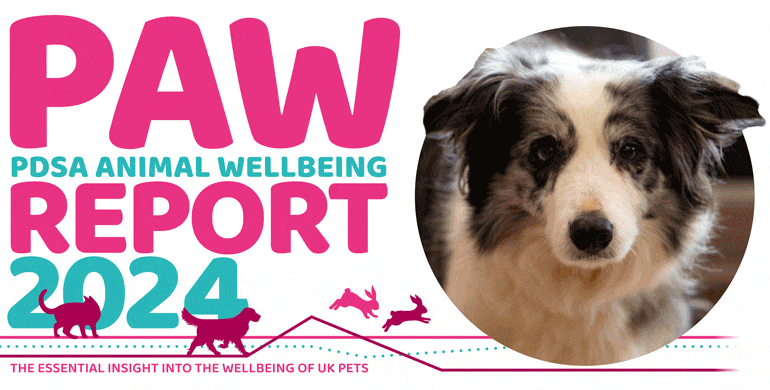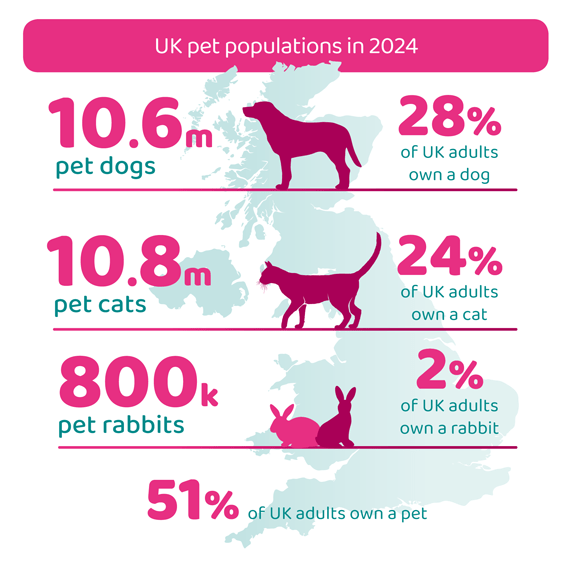
Pet Populations
Over the last 14 years, the consistent methodology of the PAW Report has enabled accurate tracking of the UK’s pet dog, cat and rabbit populations, alongside the proportion of UK adults who own a pet. Using nationally representative data collected annually, the Report provides a reliable picture of how UK pet populations are changing.
Our data shows there have been no significant changes in dog or cat ownership in the last 12 months, but we have seen a decrease for rabbits. In 2024, we estimate there are 10.6 million pet dogs, 10.8 million pet cats and 800,000 pet rabbits living in the UK.
Overall, 51% of UK adults own a pet of any type, a slight decrease from 2023, when 53% did. 28% of UK adults own a dog and 24% a cat – neither of which are different from 2023. 1.71% own a rabbit, which has decreased from 2.24% in 2023.


click to see ten years of data
Dogs
Looking at the trends, the dog population has been growing steadily since 2011 when it was 8.2 million dogs, to 10.6 million in 2024, although 2024 is not statistically significantly different from 2023.
The proportion of UK adults owning a dog has also increased over time from 23% in 2011 to 28% in 2024. This proportion did not change between 2019 and 2021 (26%) but increased to 27% in 2022 and again to 29% in 2023. The 2024 figure is not statistically significantly different from either 2023 or 2022.
Whilst the proportion of owners who have one, two, or three or more dogs has remained stable between August 2020 and 2024, these proportions have changed when compared to earlier years, with a higher proportion having 1 dog and lower proportion having multiple dogs. For example, in 2024, 74% of dog owners have one dog which is higher than in 2019 and February 2020 (both 70%) and 2018 (72%). In 2024, 5% of owners have three or more dogs, which is lower than 2019 and Feb 2020 (both 7%).
Cats
The UK pet cat population has remained relatively stable over the last 14 years despite a few fluctuations. The proportion of UK adults owning a cat has not changed over the last 10 years (24% in 2024) but is lower than in 2011 (27%). The proportion of cat owners owning one, two, or three or more cats has not changed since August 2020.
60% of owners in 2024 own one cat. This has not changed since 2020 (or 2017), but is higher than 2018 and 2019 when 56% of people owned one cat. 29% of owners in 2024 own two cats which is not statistically significantly different from all findings since 2017. 10% of owners have 3 or more cats which has not changed since August 2020, but is lower than February 2020 (12%), 2018 (13%) and 2017 (13%). It is no different from 2019.
Rabbits
There has been a decrease in the rabbit population from 2023 (1.1 million) to 2024 (800,000). The population has fluctuated over time, but new linear regression analysis conducted by PDSA shows now that there has been an overall downward trend since 2011 (1.6 million).
The proportion of UK adults who own a rabbit has fallen in 2024 (1.71%) compared to 2023 (2.24%) and 2024 is also significantly lower than 2011 when 3.72% of adults owned a rabbit. Overall, 2024 is lower than 2011 (3.72%), 2014 (2.50%), 2015 (2.63%), 2016 (3.18%), 2018 (2.45%), 2021 (2.08%), and 2023 (2.24%), but no different from 2017, 2019, 2020, or 2022.
The number of rabbits people own has not changed in 2024 compared to any of the preceding years from 2017 to 2023. There have been some variations between the years over this time period but no overarching trend.
Acquisition rates
In 2024, 14% of dog owners* have owned their pet for one year or less (1.5 million dogs), which is no different from 2023, 2022 and 2019 but higher than 2020, 2018 and 2017 (12% in August 2020, 11% in 2018 and 12% in 2017).
This appears to reflect a higher rate of acquisition of dogs in recent years. However, there is not a similarly increasing trend across the years for cats or rabbits. In 2024, 12% of cat owners* have owned their pet for one year or less (1.3 million cats), and 19% of rabbit owners* have owned their pet for one year or less (150,000 rabbits). These proportions are no different from the previous eight years.
New pet owners
In 2024, 38% of all pet owners told us that they were ‘new’ pet owners, i.e. this is their first experience of owning this species of pet as an adult, more than in 2021 (34%) and 2022 (36%) but no different from 2023. This includes 22% of pet owners who have never owned any species of pet before as an adult, a proportion which hasn’t changed since we first asked the question in 2021. The demographics of new pet owners has not changed since 2021, with new owners more likely to be younger (18-44), educated to university degree or higher, have a gross household income of £50,000 plus, live in households of three - four people, be working full time or a full-time student, living in an urban area and have children.
42% of dog owners have not owned a dog before as an adult, an increase from 2021 (34%) and 2022 (39%) but no different from 2023. There has been no change over the same time period for cat owners - 33% have not owned a cat before as an adult, which is broadly the same as in 2021, 2022 and 2023. As in previous years, more rabbit owners (44%) than dog or cat owners have not owned a rabbit before as an adult. This has decreased from 51% in 2023 but is not statistically significantly different from 2021 and 2022.
If this apparent stabilisation in the proportion of ‘new’ pet owners, together with that seen for both acquisition rates and population estimates for dogs, continue as trends, it would be interesting to investigate the reasons behind this. There are likely to be multiple factors involved, including changes in lifestyles such as a decline in the home working patterns which many adopted in response to the COVID-19 pandemic. An additional contributory factor could be that the current financial climate is affecting people’s decision to own a pet. Owners continue to tell us that the cost of living is having an impact, with 24% of owners (5.4 million pets) saying the cost of living has affected how they care for their pet, increased from 22% in 2023. This includes 1% of owners who said because of the cost of living, they were having to give up their pet for rehoming and 1% who were having to have their pet put to sleep, unchanged from 2022.

Additionally, 2% of owners told us they had to get pet food from a food bank (340,000 pets), doubled from 1% in 2023. In response to the cost of living crisis, charities, including RSPCA, Blue Cross and Dogs Trust expanded their support for pet owners through foodbanks. The Pets at Home Foundation impact report 2022-20231 reports that the Blue Cross Pet Food Bank Service funded by the Pets at Home Foundation has fed over one million pets across Northern Ireland, Wales, Scotland and England.
We will continue to monitor the proportion of new pet owners through future PAW Reports to determine whether this is a fluctuation or a true change in the trend.

Footnotes
* Excluding those who didn’t know how long they had owned their pet for
1 https://www.petsfoundation.co.uk/wp-content/uploads/2023/08/PA230501-PAH-Foundation-Impact-Report-2023-Final.pdf
